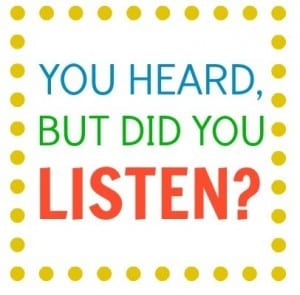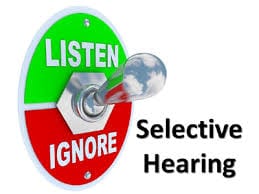 Because first responders frequently operate in environments where there are multiple auditory inputs (e.g., radio traffic, face-to-face communications, ambient sounds, etc.) they are often forced to prioritize what they listen to (or don’t listen to). This can cause issues with situational awareness.
Because first responders frequently operate in environments where there are multiple auditory inputs (e.g., radio traffic, face-to-face communications, ambient sounds, etc.) they are often forced to prioritize what they listen to (or don’t listen to). This can cause issues with situational awareness.
Listening versus hearing
 Before I get too deep into this discussion, I want to distinguish the difference between listening and hearing. Think of hearing as the mechanical process of sounds entering your ears. Unless you are wearing earmuffs or earplugs, chances are a sound within hearing distance will enter your ear canal and stimulate the eardrum. This… is hearing.
Before I get too deep into this discussion, I want to distinguish the difference between listening and hearing. Think of hearing as the mechanical process of sounds entering your ears. Unless you are wearing earmuffs or earplugs, chances are a sound within hearing distance will enter your ear canal and stimulate the eardrum. This… is hearing.
Listening, in the context of this discussion, relates to comprehending the meaning of what is heard. In other words, hearing happens on the OUTSIDE of the brain and listening happens on the INSIDE of the brain. Think about it this way. It would be nearly impossible for a person to control which sounds reach their ear canal. Yet people seemingly are able to sort out those sounds (inside the brain) and pick and choose which sounds they want to listen to. Thus, they are selectively listening.
What you choose to listen to
A great deal of scientific research has been dedicated to trying to understand what people choose to listen to. One of the findings, which isn’t all too surprising, is we listen to what we want to hear (the enjoyable message) and tune out what we don’t want to hear (the unenjoyable message).
For example, if a parent tells their child: “Clean up your room and you’ll get an ice cream cone.” It may seem the child only heard they were getting ice cream. When, in fact, it would be impossible for the child to block some of the sound waves of that same sentence from entering their ear canal. The entire sentence was heard, but the entire sentence was not comprehended.
You see what I’m saying?
 Have you ever been in a conversation where you, or the other person asks: “Do you see what I’m saying?” Or states in the affirmative: “I see what you mean!” Indeed, we do see audible messages. This is, in part, how you comprehend the meaning of audible messages. When someone says “ice cream cone” you visualize, in your mind, what those words mean. This draws the image of an ice cream cone on your mental sketchpad.
Have you ever been in a conversation where you, or the other person asks: “Do you see what I’m saying?” Or states in the affirmative: “I see what you mean!” Indeed, we do see audible messages. This is, in part, how you comprehend the meaning of audible messages. When someone says “ice cream cone” you visualize, in your mind, what those words mean. This draws the image of an ice cream cone on your mental sketchpad.
There is only one sketchpad for drawing the meaning of audible information. You can imagine how busy the sketchpad can get, especially when you are operating in environments with multiple (often competing) audible inputs. Under such conditions, the sketchpad is formed to prioritize what it will sketch.
Multitasking
If you don’t know this already (search and read the previous articles I’ve written about it), multitasking when it comes to paying attention is a myth. The human brain is incapable of paying simultaneous attention to multiple incoming inputs. You can shift attention (quickly) between sensory inputs (giving the illusion of multitasking) but the sketchpad cannot be shared. Thus, attention is given to one auditory input at a time.
Hearing but not listening
However, even when you have only one thing to listen to (i.e., only one person talking to you), it is possible to selectively listen to the message. If the sender of the message is boring, you may begin to tune them out. If the message is one that you do not want to hear (or don’t enjoy listening to) you may tune it out. If, while processing the meaning of the message your mind begins to wander (I call this “mind drift”) your sketchpad may start drawing pictures related to your drift (i.e., day dreaming).
Dr. Gasaway’s Advice
 While it is easy to see the ill effects of selective listening, it may be far more difficult to realize you are selectively listening in the moment it is happening. In order to realize you are selectively listening, you must first, with conscious effort, “unlock” your attention from what you are listening to and yield the sketchpad to another auditory input.
While it is easy to see the ill effects of selective listening, it may be far more difficult to realize you are selectively listening in the moment it is happening. In order to realize you are selectively listening, you must first, with conscious effort, “unlock” your attention from what you are listening to and yield the sketchpad to another auditory input.
Here’s an example. You’re at home watching your favorite sport on television. The game is at a point of high intensity and you are attentively listening. You may be oblivious to the fact that your significant other is trying to carry on a conversation with you. You may be “half listening” to the conversation (meaning you are shifting attention back and forth between the competing inputs.
You may also be completely tuned out to the conversation. Only after you unlock your auditory attention from the game and shift it to the conversation will you truly understand the meaning of what is being said. However, in order to do this, you must first stop listening to the game. This may be harder than it appears.
Selective listening on an emergency scene is common because there are so many competing inputs (not just spoken words, but sounds also compete for control of your attention). Understand while you are processing the meaning of one input, another input (containing critical information) may not be comprehended. If this happens, you may not even know it’s happened.
It is a mistake to assume that simply because something is said, the receiver understands it. Even if the receiver says: “Message received” or “10-4” it doesn’t mean they understood. Hell, even if they say they understood it doesn’t mean they truly understood, your intended meaning of the message.
Action Items
 Discuss a time when selective listening caused you to miss an important message.
Discuss a time when selective listening caused you to miss an important message.- Discuss strategies you can use to help combat challenges with selective listening.
- Discuss the signs and symptoms that may be observable when you (or someone you are talking with) may be selectively listening.
_____________________________________________________

If you are interested in taking your understanding of situational awareness and high-risk decision making to a higher level, check out the Situational Awareness Matters Online Academy.
CLICK HERE for details, enrollment options and pricing.
__________________________________
Share your comments on this article in the “Leave a Reply” box below. If you want to send me incident pictures, videos or have an idea you’d like me to research and write about, contact me. I really enjoy getting feedback and supportive messages from fellow first responders. It gives me the energy to work harder for you.
Thanks,

Email: Support@RichGasaway.com
Phone: 612-548-4424
SAMatters Online Academy
Facebook Fan Page: www.facebook.com/SAMatters
Twitter: @SAMatters
LinkedIn: Rich Gasaway
Instagram: sa_matters
YouTube: SAMattersTV
iTunes: SAMatters Radio
iHeart Radio: SAMatters Radio

I agree with all of what you’ve said, especially the part where we could only entertain a single input but can shift it quickly to entertain the other inputs as well, giving us the illusion of multi-tasking. And all those actions accumulate to form meanings, whatever might those be. Lol
Pingback: Race & Communication (Listening) – American Construction of the Self
I’ve noticed a plethora of selective listeners and selective readers who generally focus to satisfy their own emotional and self-interest situations. It also include active denial and even aggression increasingly prevalent in our media driven world. People are becoming less learned and less creative in their day to day lives.